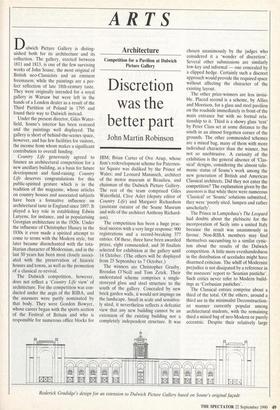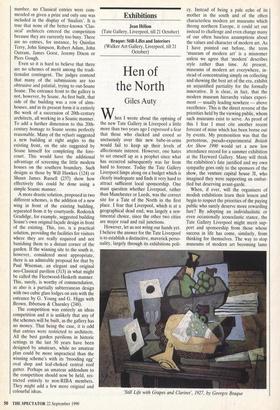ARTS
Architecture
Competition for a Pavilion at Dulwich Picture Gallery
Discretion was the better part
John Martin Robinson
Dulwich Picture Gallery is disting- uished both for its architecture and its collection. The gallery, erected between 1811 and 1813, is one of the few surviving works of John Soane, the most original of British neo-Classicists and an eminent freemason; while the paintings are a per- fect reflection of late 18th-century taste. They were originally intended for a royal gallery in Warsaw but were left in the hands of a London dealer as a result of the Third Partition of Poland in 1795 and found their way to Dulwich instead.
Under the present director, Giles Water- field, Soane's interior has been restored and the paintings well displayed. The gallery is short of behind-the-scenes space, however, and has few facilities for visitors, the income from whom makes a significant contribution to overall funding.
Country Life generously agreed to finance an architectural competition for a new ancillary building, as a basis for future development and fund-raising. Country Life deserves congratulations for this public-spirited gesture which is in the tradition of the magazine, whose articles on country houses and associated subjects have been a formative influence on architectural taste in England since 1897. It played a key role in establishing Edwin Lutyens, for instance, and in popularising Georgian architecture in the 1920s. Under the influence of Christopher Hussey in the 1930s it even made a spirited attempt to come to terms with the Modern style, but later became disenchanted with the tota- litarian character of Modernism, and in the last 50 years has been most closely associ- ated with the preservation of historic houses and towns, as well as the promotion of a classical re-revival.
The Dulwich competition, however, does not reflect a 'Country Life view' of architecture. For the competition was con- ducted under the aegis of the RIBA, and the assessors were partly nominated by that body. They were Gordon Bowyer, whose career began with the sports section of the Festival of Britain and who is responsible for numerous office blocks for IBM; Brian Carter of Ove Arup, whose firm's redevelopment scheme for Paternos- ter Square was disliked by the Prince of Wales; and Leonard Manasseh, architect of the motor museum at Beaulieu, and chairman of the Dulwich Picture Gallery. The rest of the team comprised Giles Waterfield, Clive Aslet (deputy editor of Country Life) and Margaret Richardson (assistant curator of the Soane Museum and wife of the architect Anthony Richard- son).
The competition has been a huge prac- tical success with a very large response: 900 registrations and a record-breaking 377 entries. Of these, three have been awarded prizes, eight commended, and 30 finalists selected for exhibition at the gallery until 14 October. (The others will be displayed from 25 September to 7 October.) The winners are Christopher Grasby, Brendan O'Neill and Tom Zetek. Their understated scheme comprises a single- storeyed glass and steel structure to the south of the gallery. Concealed by new brick garden walls, it would not impinge on the landscape. Small in scale and sensitive- ly sited, it nevertheless reflects a defeatist view that any new building cannot be an extension of the existing building nor a completely independent structure. It was chosen unanimously by the judges who considered it a 'wonder of discretion'.
Several other submissions are similarly low-key and informal — one concealed by a clipped hedge. Certainly such a discreet approach would provide the required space without affecting the character of the existing layout.
The other prize-winners are less invisi- ble. Placed second is a scheme, by Allies and Morrison, for a glass and steel pavilion on the roadside immediately in front of the main entrance but with no formal rela- tionship to it. Third is a showy glass 'tent' by Peter Class set at some distance to the south in an almost forgotten corner of the grounds. The other commended schemes are a mixed bag, many of them with more individual character than the winner, but not so unobtrusive. A curiosity of the exhibition is the general absence of 'Clas- sical' designs, considering the almost talis- manic status of Soane's work among the new generation of British and American Classical architects. Did they not enter the competition? The explanation given by the assessors is that while there were numerous 'Classical' or `Soanic' solutions submitted, they were 'poorly sited, lumpen and rather unscholarly'.
The Prince in Lampedusa's The Leopard had doubts about the plebiscite for the
incorporation of Sicily into a united Italy because the result was unanimously in favour. Non-RIBA members may find themselves succumbing to a similar cynic- ism about the results of the Dulwich competition. A little more evenhandedness in the distribution of accolades might have disarmed criticism. The whiff of Modernist prejudice is not dissipated by a reference in the assessors' report to `Soanian pastiche'. Such critics never refer to Modern build- ings as 'Corbusian pastiches'.
The Classical entries comprise about a third of the total. Of the others, around a third are in the minimalist Deconstruction- ist manner currently popular among architectural students, with the remaining third a mixed bag of neo-Modern or purely eccentric. Despite their relatively large Roderick Gradidge's design for an extension to Dulwich Picture Gallery based on Soane's original façade number, no Classical entries were com- mended or given a prize and only one was included in the display of 'finalists'. It is true that none of the better-known 'Clas- sical' architects entered the competition because they are currently too busy. There are no entries, for instance, by Quinlan Terry, John Simpson, Robert Adam, John Outram, James Gorst, Jeremy Dixon or Piers Gough.
Even so it is hard to believe that there are no schemes of merit among the tradi- tionalist contingent. The judges contend that many of the submissions are too obtrusive and palatial, trying to out-Soane Soane. The entrance front to the gallery is not, however, by Soane. As first built, that side of the building was a row of alms- houses, and in its present form it is entirely the work of a succession of 20th-century architects, all working in a Soanic manner.
To add a further dimension to this 20th-
century homage to Soane seems perfectly reasonable. Many of the refuses suggested
a new building at right angles to the existing front, on the site suggested by Soane himself for completing the fore- court. This would have the additional advantage of screening the little modern houses on the southern boundary. Such designs as those by Will Hawkes (124) or Shaun James Russell (237) show how effectively this could be done using a simple Soanic manner.
A more drastic solution, proposed in two different schemes, is the addition of a new wing in front of the existing building, separated from it by courtyards. Roderick Gradidge, for example, suggested building Soane's own original façade design in front of the existing. This, too, is a practical solution, providing the facilities for visitors where they are really required and not banishing them to a distant corner of the garden. If the winning site to the south is, however, considered most appropriate, there is an admirable proposal for that by Paul Wiseman, an elegant and original neo-Classical pavilion (313) in what might be called the Fleetwood-Hesketh manner. This, surely, is worthy of commendation, as also is a partially subterranean design with two cubic glass lodges on axis with the entrance by G. Young and G. Higgs with Brown, Ibbotson & Charnley (248).
The competition was entirely an ideas competition and it is unlikely that any of the schemes will be built, as the gallery has no money. That being the case, it is odd that entries were restricted to architects.
All the best garden pavilions in historic settings in the last 50 years have been designed by amateurs, while no amateur plan could be more impractical than the winning scheme's with its 'brooding egg' oval shop and leaf-choked central roof gutter. Perhaps an amateur addendum to the competition should now be held, res- tricted entirely to non-RIBA members. They might add a few more original and colourful ideas.



































































 Previous page
Previous page